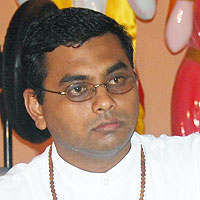August 29, 2014 will mark the auspicious occasion of Shri Ganesh Jayanti, signalling the commencement of the spiritually charged and celebratory period of Ganesh Utsav. This period is marked by 11 days of devotion to Shri Ganesh coupled with celebrations in the form of dances, plays and other such performances. Temples and community streets are decorated with banners and streamers, which dance in the wind as if they themselves are enjoying the festivities for Shri Ganesh. Clay murtis are paraded through the streets of the nation accompanied by masses of devotees on foot and in motorcades, all carrying in hand ladoo, coconut, prasad, fruits, pushpam and doob mala to offer to Shri Ganesh. The beat of tassa drums, the resonance of bhajan and kirtan from music trucks all impact the mind and senses as we feel the presence of Shri Ganesh in our beloved nation.
The question can be asked, of course, why do we enjoy this period of Shri Ganesh Utsav? Many would attest to the power of Shri Ganesh in their lives and therefore, this occasion provides an opportunity for devotees to express their gratitude and give recognition to a Hindu Icon. Yet others are bhaktas by nature and enjoy the heavy vibrations that emanate from these celebrations. They are able to connect to the spirituality of the occasion and experience a sense of divinity not felt on an average day. For some devotees, the occasion is marked by a variety of activities, including rituals, which gives to them an opportunity to make sacrifices of a physical and tangible nature to Bhagwan Ganesh.
Regardless of the motivation for engaging ourselves in Shri Ganesh Utsav, we can be assured that blessings come our way from such engagements. Shri Ganesh is Vignaharan (destroyer of obstacles) and Gyaandaata (giver of wisdom). When we say that Shri Ganesh is the destroyer of obstacles and the giver of wisdom, is it that he would personally come and relieve our distresses? It may be that we can make Bhagwan appear through intense devotions; however, such outcomes are far beyond the reach of the average person. Therefore we should see Shri Ganesh not only as the giver of these benefits but as principles, which when applied to our lives, bring about these positive outcomes.
When we look at the physical form of Shri Ganesh certain features stand out. We see the large flapping ears, small eyes and the unique trunk that covers the mouth. These physical features represent certain practices, which when applied to daily living, bring about certain benefits. The small eyes say to us that our vision should be controlled; only see God and good. The flapping ears say that we should close our ears to that which is negative; only listen to that which is uplifting. The covered mouth tells us that we should be very guarded in our intake and output using the mouth; eat Sattwic bhojan and speak positive and uplifting words.
The message that can be gleaned from the form of Shri Ganesh, therefore, is control of the gyaan indriyas (senses of perception). When we can control the senses then we earn spiritual wealth (shatsampati). These forms of spiritual wealth are powerful weapons to battle the possible threats of daily living and so protect our lives.
Therefore, while Shri Ganesh is indeed Saguna Brahma (a personal form of God), beyond this he is also a personification of ideal principles. As we prepare for and celebrate Shri Ganesh Utsav 2014, let us all ensure that along with the rituals and celebrations, we gain a deeper understanding of our beloved Shri Ganesh. Swaha’s drive is to guide us towards a greater sense of enlightened ritualism.
Jai Shri Ganesh.
By Pt. Jaidath Maharaj, Spiritual Leader, Swaha Gyaan Jyoti Mandali


